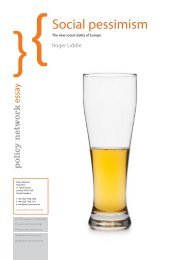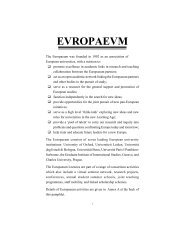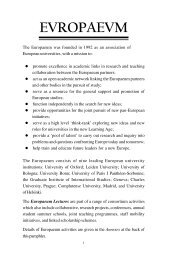to download a Special Report of this meeting - The Europaeum
to download a Special Report of this meeting - The Europaeum
to download a Special Report of this meeting - The Europaeum
You also want an ePaper? Increase the reach of your titles
YUMPU automatically turns print PDFs into web optimized ePapers that Google loves.
Anglo-American and European Models<br />
lighted some <strong>of</strong> the important differences<br />
between the approach in America (also noted by<br />
An<strong>to</strong>nio) and the approach taken in Britain. I<br />
will come back <strong>to</strong> that in a moment. Second,<br />
does the European model exist We have talked<br />
about some <strong>of</strong> the differences with reference<br />
shareholders in certain markets, and there are<br />
also differences <strong>to</strong> do with voting and infrastructure.<br />
I propose that there is actually no such<br />
thing as the “European model.”<br />
Institutional inves<strong>to</strong>rs are important players<br />
in <strong>this</strong> – <strong>of</strong> course I would say that, but nonetheless<br />
– they are the people who are involved along<br />
the length <strong>of</strong> the governance chain, providing the<br />
glue between the inves<strong>to</strong>rs, the shareholders,<br />
ultimately the men in the street, and the companies<br />
in which we invest. And inves<strong>to</strong>rs themselves<br />
are not homogeneous: in particular, hedge<br />
funds are very diverse. Where do they fit in<strong>to</strong><br />
corporate governance<br />
Lastly, in sharing my views with you, I want<br />
<strong>to</strong> <strong>to</strong>uch a little bit on the question <strong>of</strong> engagement,<br />
which is an important catalyst in making<br />
sure corporate governance actually works.<br />
Particularly between institutions and companies,<br />
but it perhaps goes further down the chain as<br />
well.<br />
In terms <strong>of</strong> the myths <strong>of</strong> models, it seems <strong>to</strong><br />
me, having been in <strong>this</strong> so-called business for a<br />
number <strong>of</strong> years now, that corporate governance<br />
is more about chains, and the chains can be<br />
extremely complex – like playing three-dimensional<br />
chess at times.<br />
At the very basic level, you have at one end<br />
the inves<strong>to</strong>r, who gives his money <strong>to</strong> Standard<br />
Life Investments, who then invests it in the company.<br />
<strong>The</strong> company pays the dividend, which<br />
comes back <strong>to</strong> Standard Life Investments, and is<br />
then put in<strong>to</strong> our client’s pension or other investment<br />
vehicle.<br />
When we come back <strong>to</strong> the complex governance<br />
chain, <strong>this</strong> relationship takes on new<br />
dimensions. Our clients come in different shapes<br />
and sizes. Sometimes we have pension funds,<br />
sometimes we have charities; sometimes the pension<br />
funds are large, with demographically<br />
mature members, and sometimes they are young.<br />
Each has different preferences and different liabilities.<br />
<strong>The</strong>re are NGOs that impact on the governance<br />
chain, which themselves represent different<br />
subsections <strong>of</strong> men in the street (the ultimate<br />
beneficiaries <strong>of</strong> all <strong>this</strong>). <strong>The</strong>re are representative<br />
bodies, governments, legisla<strong>to</strong>rs… and down<br />
at the company end you have different companies<br />
in different jurisdictions, with their attendant<br />
reference shareholders and disparate goals.<br />
Within the chain, you have a lot <strong>of</strong> complexity,<br />
and the chain is only as strong as its weakest<br />
link. <strong>The</strong>re are different chains in different jurisdictions,<br />
and even different chains in the same<br />
jurisdiction. <strong>The</strong>re is evidence <strong>of</strong> <strong>this</strong> in the UK<br />
when, after privatisation, a number <strong>of</strong> companies<br />
had special shares (“golden shares”), which carried<br />
different rights <strong>to</strong> the others.<br />
But chains have the same beginning and the<br />
same end. We talk a lot about the chain going<br />
from the institution down <strong>to</strong> the company, but<br />
the chain is ultimately my client’s money going<br />
from us <strong>to</strong> the company, and back as a dividend.<br />
My clients are the beginning and the end <strong>of</strong> that<br />
chain, but when you speak <strong>to</strong> our clients walking<br />
around Oxford, they are almost entirely unaware<br />
<strong>of</strong> corporate governance.<br />
In my ten, eleven years at Standard Life dealing<br />
with <strong>this</strong> responsibility <strong>to</strong>wards 2.5 million<br />
policyholders, I have probably received twenty or<br />
thirty letters about corporate responsibility and<br />
how we perceive our responsibilities about corporate<br />
governance. From a macro policy level,<br />
we have a big issue relating <strong>to</strong> the education <strong>of</strong><br />
inves<strong>to</strong>rs on investment practices, and corporate<br />
governance is an important subset <strong>of</strong> <strong>this</strong> education.<br />
In terms <strong>of</strong> dealing with chains, each company<br />
has a unique corporate governance DNA. No<br />
two companies are the same: they have different<br />
shareholders and different regulations. That is<br />
the great interest for me in corporate governance<br />
– no two companies or situations are ever quite<br />
the same. I get <strong>to</strong> match the style <strong>of</strong> the inves<strong>to</strong>r<br />
<strong>to</strong> the different styles and DNAs <strong>of</strong> the companies.<br />
<strong>The</strong> DNA will determine the cultural style<br />
<strong>of</strong> the company, and as ever, the DNA chain is<br />
only as strong as the weakest link.<br />
Moving along <strong>to</strong> institutional inves<strong>to</strong>rs, I<br />
believe they can control the governance chain.<br />
Whether they do control the chain is another<br />
question al<strong>to</strong>gether, but institutional inves<strong>to</strong>rs<br />
are involved both in policy engagement and in<br />
corporate engagement. <strong>The</strong>y lobby on policy,<br />
largely through representative bodies but also<br />
individually. <strong>The</strong>y use the media as a mechanism<br />
for lobbying views on particular policy.<br />
In terms <strong>of</strong> engagement, institutions are<br />
involved in both proactive corporate engagement,<br />
and in reactive engagement where institutions<br />
have <strong>to</strong> roll up their sleeves and get<br />
involved. Cable and Wireless is an example <strong>of</strong><br />
<strong>this</strong>; Marconi is another.<br />
Reactive engagement has been much in the<br />
news lately, but proactive engagement is just as<br />
important: it is where we pick up the phone <strong>to</strong><br />
companies, and say “can we come round and<br />
have a cup <strong>of</strong> c<strong>of</strong>fee” <strong>The</strong>re may not be a particular<br />
issue <strong>to</strong> talk about, but it is an important<br />
part <strong>of</strong> the dialogue between institutions and corporations,<br />
keeping the chain <strong>to</strong>gether.<br />
Comparing between the different jurisdictions<br />
in the US, the chain tends <strong>to</strong> be litigious and con-<br />
37
















